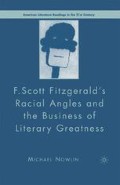Abstract
Reviewing the recently published Trimalchio: An Early Version of The Great Gatsby (2000), Claudia Roth Pierpont recalls as a great mystery “the fact that the facile and fizzy author [Fitzgerald] produced what may be the century’s most widely read and admired American novel… .”1 Her irreverence takes nothing away from what she regards as a fait accompli, though a wide, admiring readership would only evolve over time. That The Great Gatsby has succeeded in the long run so well, however, seems no accident.
Preview
Unable to display preview. Download preview PDF.
Notes
Claudia Roth Pierpont, “For Love and Money,” New Yorker 76 (July 3, 2000): 77.
For first-rate descriptions of The Great Gatsby as a modernist text, see Ronald Berman, The Great Gatsby and Modern Times (Urbana: University of Illinois Press, 1994)
Hugh Kenner, A Homemade World: The American Modernist Writers (Baltimore: Johns Hopkins University Press, 1975), 23–43
See Sheilah Graham, College of One (New York: Viking, 1967), 86–87.
Though I mean to reveal in this chapter how troubled and troubling Nick’s authoritative position in the novel is, I accept the standard view that he represents a technical advance derived mainly from Fitzgerald’s reading of Conrad, as well as the assumption that we are to understand Nick as having a greater capacity for disinterested judgment (moral and aesthetic) than any other character in the book. What I think of as a more “traditional” reading of Nick is influentially represented, e.g., by Sergio Perosa, The Art of F. Scott Fitzgerald (Ann Arbor: University of Michigan Press, 1965), 62–66
Henry Dan Piper, F. Scott Fitzgerald: A Critical Portrait (Carbondale: Southern Illinois University Press, 1965), 107–11
James E. Miller, Jr., F. Scott Fitzgerald: His Art and His Technique (New York: New York University Press, 1964), 118–23
Richard D. Lehan, F. Scott Fitzgerald and the Craft of Fiction (Carbondale: Southern Illinois University Press, 1966), 109–12
Robert Sklar, F. Scott Fitzgerald: The Last Laocoön (New York: Oxford University Press, 1967), 175–80
Milton R. Stern, The Golden Moment: The Novels of F. Scott Fitzgerald (Urbana: University of Illinois Press, 1970), 191–96
Brian Way, F. Scott Fitzgerald and the Art of Social Fiction (London: Edward Arnold, 1980), 116–17.
See Berman’s discussion of this theme in The Great Gatsby and Modern Times, 125–30. Also see Meredith Goldsmith, “White Skin, White Mask: Passing, Posing, and Performing in The Great Gatsby,” Modern Fiction Studies49 (fall 2003): 447–51
On the first recorded use of this term, see Janice A. Radway, A Feeling for Books (Chapel Hill: University of North Carolina Press, 1997), 218–19.
Michael North, Reading 1922: A Return to the Scene of the Modern (New York: Oxford University Press, 1999), 4.
For excellent critical histories of the rise of the “middlebrow” as a cultural category as well as the key institutions such as the Book-of-the-Month Club that sustained it, see Radway, A Feeling for Books, 219–60, as well as Joan Shelley Rubin, The Making of Middlebrow Culture (Chapel Hill: University of North Carolina Press, 1992), xi–xx
Important instances of this critical viewpoint have been around for some time: see M. Gidley, “Notes on F. Scott Fitzgerald and the Passing of the Great Race,” Journal of American Studies 7 (1973): 171–81
Peter Gregg Slater, “Ethnicity in The Great Gatsby” Twentieth Century Literature 19 (January 1973): 53–62
See Eric Lott, Love and Theft: Blackface Minstrelsy and the American Working Class (New York: Oxford University Press, 1993), 38–62.
See Mitchell Breitwieser, “The Great Gatsby: Grief, Jazz and the Eyewitness,” Arizona Quarterly 47 (autumn 1991), 62–66
The contrary view persists that Fitzgerald knew and cared little about authentic (black) jazz: see Robert M. Crunden, Body and Soul: The Making of Modernism (New York: Basic Books, 2000), 237–38
Kathy Ogren, The Jazz Revolution: Twenties America & the Meaning of Jazz (New York: Oxford University Press, 1989), 149–50.
See Billie Melman, Women and the Popular Imagination in the Twenties (London: Macmillan, 1988), 90
Sarah Wintle, “The Sheik What Can Be Made of a Daydream,” Women: A Cultural Review 7 (winter 1996), 292.
See Irving Shulman, Valentino (London: Leslie Frewin, 1968), 160–62.
Copyright information
© 2007 Michael Nowlin
About this chapter
Cite this chapter
Nowlin, M. (2007). “Trashy Imaginings” and The “Greatness” of The Great Gatsby. In: F. Scott Fitzgerald’s Racial Angles and the Business of Literary Greatness. American Literature Readings in the 21st Century. Palgrave Macmillan, New York. https://doi.org/10.1007/978-1-137-11647-5_4
Download citation
DOI: https://doi.org/10.1007/978-1-137-11647-5_4
Publisher Name: Palgrave Macmillan, New York
Print ISBN: 978-1-349-73802-1
Online ISBN: 978-1-137-11647-5
eBook Packages: Palgrave Literature & Performing Arts CollectionLiterature, Cultural and Media Studies (R0)

